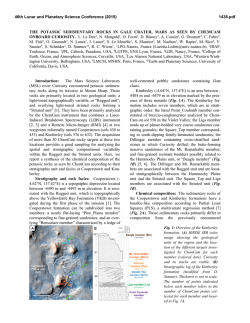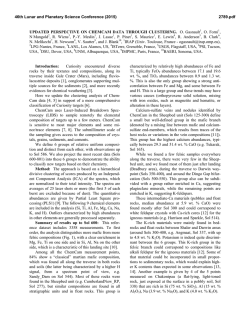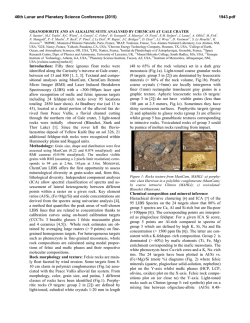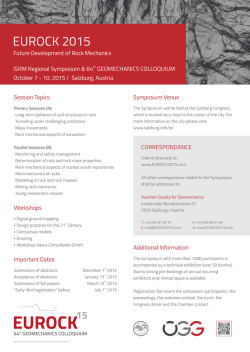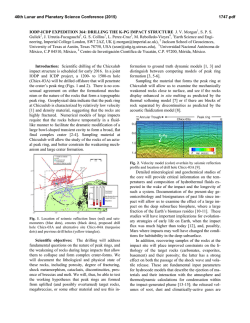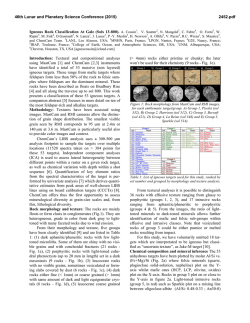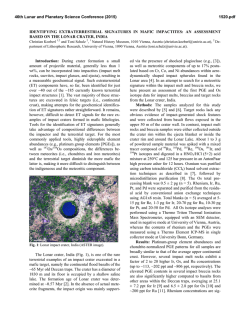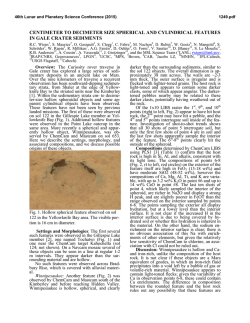
Constraining the Texture and Composition of Pore - USRA
46th Lunar and Planetary Science Conference (2015) 2234.pdf CONSTRAINING THE TEXTURE AND COMPOSITION OF PORE-FILLING CEMENTS AT GALE CRATER, MARS. K. L. Siebach1, J. P. Grotzinger1, S. M. McLennan2, J. A. Hurowitz2, D. W. Ming3, D. T. Vaniman4, E. B. Rampe5, D. L. Blaney6, L. C. Kah7, and the MSL Science Team. 1Division of Geological and Planetary Sciences, California Institute of Technology, Pasadena, CA, ([email protected]), 2Department of Geosciences, Stony Brook University, Stony Brook, NY, 3NASA JSC, Houston, TX, 4Planetary Science Institute, Tucson, AZ, 5Aerodyne Industries, Jacobs JETS Contract, NASA JSC, Houston, TX, 6NASA JPL, California Institute of Technology, Pasadena, CA, 7University of Tennessee, Department of Earth and Planetary Sciences, Knoxville, TN Introduction: The Mars Science Laboratory (MSL) rover Curiosity has encountered a wide variety of sedimentary rocks deposited in fluvio-lacuestrine sequences at the base of Gale Crater [1]. The presence of sedimentary rocks requires that initial sediments underwent diagenesis and were lithified. Lithification involves sediment compaction, cementation, and recrystallization (or authigenic) processes. Analysis of the texture and composition of the cement can reveal the environmental conditions when the cements were deposited, enabling better understanding of early environments present within Gale Crater. The first step in lithification is sediment compaction. The Gale crater sediments do not show evidence for extensive compaction prior to cementation; the Sheepbed mudstone in Yellowknife Bay (YKB) has preserved void spaces (“hollow nodules”), indicating that sediments were cemented around the hollow prior to compaction [2], and conglomerates show imbrication [3], indicating minimal grain reorganization prior to lithification. Furthermore, assuming the maximum burial depth of these sediments is equivalent to the depth of Gale Crater, the sediments were never under more than 1 kb of pressure, and assuming a 15 °C/km thermal gradient in the late Noachian, the maximum temperature of diagenesis would have been ~75 °C [4]. This is comparable to shallow burial diagenetic conditions on Earth. The cementation and recrystallization components of lithification are closely intertwined. Cementation describes the precipitation of minerals between grains from pore fluids, and recrystallization (or authigenesis) is when the original sedimentary mineral grains are altered into secondary minerals. The presence of authigenic smectites and magnetite in the YKB formation suggests that some recrystallization has taken place [5]. The relatively high percentage of XRD-amorphous material (25-40%) detected by CheMin [6, 7] suggests that this recrystallization may be limited in scope, and therefore may not contribute significantly to the cementing material. However, relatively persistent amorphous components could exist in the Martian environment (e.g. amorphous MgSO4), so recrystallization, including loss of crystallinity, cannot yet be excluded as a method of cementation. In order to describe the rock cementation, both the rock textures and their composition must be considered. Here, we attempt to summarize the current understanding of the textural and compositional aspects of the cement across the rocks analyzed by Curiosity to this point. Textural Observations: Macro-scale. Textural observations of the rocks Curiosity has surveyed begin at the macro scale. Current holistic sedimentary models describe the formation of the traversed units using an aggradational delta model, which implies at least two sediment sources [8, 9]. Mastcam observations at a smaller scale show scarp erosion, indicating that different rock units have differential resistance to erosion, which could be related to different units having different grain sizes, shapes, compositions and likely differential cementation. Observations at the unit scale show dispersed cement, rather than concentrated cement-rich layers as might be expected in “cretes”, and a lack of distinct pedogenic textures. Mastcam-based evidence therefore suggests relatively homogeneous pore-filling cement distribution within units, differential cementation between units, and at least two sediment source regions. Chemically, this implies that variability between units could represent differential cementation, but this signal could be obscured by mixtures of distinct sediment sources. Figure 1. MAHLI image of Gillespie Lake, sol 132. Red outlines grains, yellow outlines apparent voids. Note that some apparent voids are larger than typical grains, indicating secondary porosity. In this image, the average circled grain is 460 µm, the apparent voids cover 2.4% of the image area, and 12% of the voids are larger than the average grain area. 46th Lunar and Planetary Science Conference (2015) MAHLI-scale. Finer scale observations of outcrops are based on rocks imaged by the Mars Hand Lens Imager (MAHLI) instrument, which typically images rocks at a scale of ~30 µm/pixel (and periodically at higher resolutions, up to ~12.5 µm/pixel), allowing distinction of grains as small as fine sand [10]. Even at this resolution, cements are not individually distinguished, and some grains are too fine to be seen. However, a first-order calculation of porosity has been completed for a few of the sandstones along the traverse based on visible apparent void spaces between grains. This calculation is an approximation because the images are of surfaces exposed to abrasion, so excess voids could be counted because of surface erosion, and because the resolution limit means that small or intergranular pore spaces may not be included. However, the initial results indicate that apparent porosities of sandstones are very low (measured at <5%) [11]. Furthermore, comparison of average apparent surface void area compared to the average of the largest visible grains in the rock showed that, in measured samples, up to 50% of the apparent void spaces are larger by area than the largest grains in the rock. If these voids are reflective of voids within the rock (rather than just at the surface), these indicate that secondary pore fluids with distinct chemistries interacted with the rock after initial lithification because initial fluids would act to cement the rock and later, distinct, fluids would be required to dissolve the sediment or cement [11]. Both of these observations are consistent with ChemCam observations in the YKB and Kimberley outcrops of fracture fills with distinctive chemical signatures (e.g. CaSO4 [12], MnO [13]) that do not permeate into the rock surrounding the fracture, indicating that the rocks had low permeability prior to late-stage, chemically distinct, fracture fills. Chemical Observations: The Curiosity rover can measure elemental chemistry of rocks using the ChemCam (spot size ~400 µm) and APXS (spot size ~1.6 cm) instruments, and mineralogy of collected samples with the CheMin instrument. Within a set of sedimentary rocks with approximately the same sediment source region, chemical variation between samples could be related to the presence or absence of a cementing component, potentially relating to the original porosity or permeability of the sediments. This is complicated by the presence of sediments from at least two source regions, but allows a general impression of which elements may have been mobilized and concentrated or depleted by cementing pore fluids. Furthermore, secondary mineral components observed in CheMin samples could show compositions consistent with apparently mobile elements, and apparently mo- 2234.pdf bile elements may show preferential enrichment or depletion based on rock grain size. So far, observations of elemental variability and secondary mineral compositions are consistent with iron and magnesium mobility and an Fe-based cement. ChemCam observations of the Rocknest suite of rocks showed that among fine-grained rocks with high textural variability, FeO concentration was high (15-26%), variable, and not correlated with other elements [14]. APXS observations between YKB and the Darwin outcrop (first ~third of the traverse) plotted on a mafic ternary diagram (Al2O3, FeOtotal+MgO, CaO+NaO+K2O) show variability primarily along the FeOT+MgO axis. That variability is preserved (although complicated by other trends) when rocks from YKB and Pahrump are included [see McLennan et al. abstract, this meeting]. Current work aims to compare these trends with rock textures defined by analysis of associated MAHLI images. Secondary minerals observed by CheMin are also consistent with FeOT+MgO mobility; these include magnetite, hematite, akaganeite, smectite, Fe-sulfides, and iron-containing amorphous components [6, 7]. Summary: The Curiosity rover observations from the past two years reveal a complex history of diagenesis within Gale Crater. Modeling restricts burial diagenesis to <75 °C and <1 kb. Sedimentology implicates multiple source regions and a lack of pedogenesis. Textures and ChemCam observations indicate that the rocks are moderately to well cemented, with low porosity and low permeability, and also show that later pore fluids with more exotic compositions likely created secondary porosity in some rocks and filled fractures with distinct minerals. Compositional observations are consistent with FeOT+MgO mobility, which could form FeO cements, and is consistent with a variety of secondary Fe-bearing minerals observed by CheMin. References: [1] Grotzinger, J. P. et al. (2014) Science, 343, 1242777. [2] Stack, K.M. et al. (2014) JGR, 119, 1637-1664. [3] Williams, R.M. et al. (2013) Science, 340, 6136, 1068-1072. [4] Hahn, B.C. et al. (2011) LPS XLII, Abstract #2340. [5] McLennan, S.M. et al. (2014) Science, 343, 6169. [6] Vaniman, D. et al. (2014) Science, 343, 6169. [7] Morris, R. et al. (2014) LPS XLV, Abstract #1319. [8] Grotzinger, J. P. et al. (2014) AGU, P42C-01. [9] Gupta, S. et al. (2014) AGU, P42C-02. [10] Edgett, K.S. et al. (2012) Space Science Reviews, 170, 259-317. [11] Siebach, K. and Grotzinger, J. (2014) 8th Mars Conf, Abstract #1466. [12] Nachon, M. et al. (2014) JGR, 119, 1991-2016. [13] Lanza, N.L. et al. (submitted) Nature. [14] Blaney, D.L. et al. (2014) JGR, 119, 2109-2131.
© Copyright 2026
